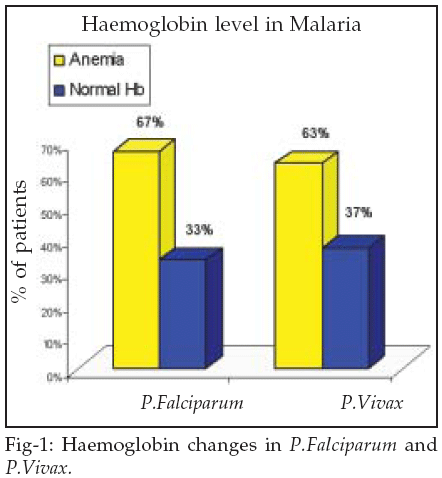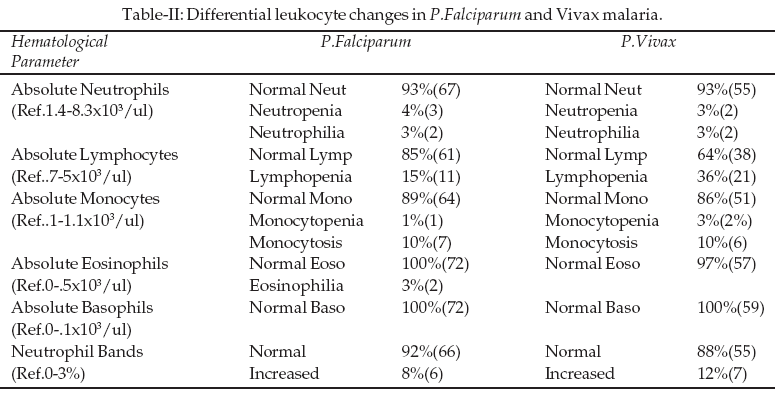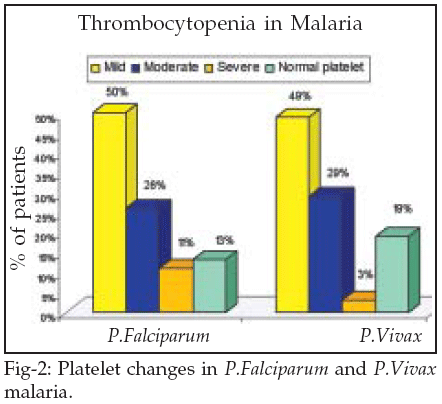|
|
||||
|
Published by : PROFESSIONAL MEDICAL PUBLICATIONS |
||||
|
ISSN 1681-715X |
||||
|
||||
|
- |
||||
|
ORIGINAL ARTICLE |
||||
|
- |
||||
|
Volume 24 |
April - June 2008 (Part-I) |
Number 2 |
||
|
|
||||
|
||||
|
|
||||
|
Published by : PROFESSIONAL MEDICAL PUBLICATIONS |
||||
|
ISSN 1681-715X |
||||
|
||||
|
- |
||||
|
ORIGINAL ARTICLE |
||||
|
- |
||||
|
Volume 24 |
April - June 2008 (Part-I) |
Number 2 |
||
|
|
||||
|
||||
Malaria and Hematological changes
Ali Hassan Abro1, Abdulla
Mahmood Ustadi2, Nadeem Javeed Younis3,
Ahmed Saleh Abdou4, Dujana Al Hamed5, Ahmed Alhaj Saleh6
ABSTRACT
Objectives: The hematological changes associated with acute malaria are well recognized. This study was conducted to assess and compare the incidence and severity of hematological changes in various types of malaria in adult population.
Methodology: This observational study included 133 acute malaria patients admitted in the Infectious Diseases Unit of Rashid Hospital Dubai (JCI accredited) UAE, during January 2005 to December 2007. The diagnosis of malaria was confirmed by thick and thin film stained with Leishman,s staining for malarial parasite. Slides were reviewed by hematologist and FBC were performed using an automated Beckman Coulter machine.
Results: Overall 83% of the patient had thrombocytopenia, 64% anemia, 24% lymphopenia and 10% monocytosis. The incidence of thrombocytopenia was slightly more in P. Falciparum (87%) than P. Vivax (81%) cases, p value >0.05, where as there was no significant difference in the incidence of anemia in two groups (67% vs 63%)-p value >0.05. However, lymphopenia was observed in 36% in P. Vivax as compared to 15% in P.Falciparum cases, p value <0.04. Eosinophil and basophil count was normal in both groups.
Conclusions: P.Falciparum as well as P.Vivax can cause significant hematological changes with high frequency of thromboctopenia, anemia lymphopenia and monocytosis.
KEY WORDS: Hematological changes, P.Falciparum, P.Vivax.
Pak J Med Sci April - June 2008 (Part-I) Vol. 24 No. 2 287-291
1. Ali Hassan Abro, FCPS, MRCP
2. Abdulla Mahmood Ustadi,
M.Sc Tropical Medicine,
3. Nadeem Javeed Younis, MRCPI,
4. Ahmed Saleh Abdou, FRCPI,
5. Dujana Al Hamed, MRCP
6. Ahmed Alhaj Saleh, MRCP
1-6: Infectious Diseases Unit,
Rashid Hospital Dubai, UAE.
Correspondence
Ali Hassan Abro,
Ward 17,
Rashid Hospital Dubai,
P.O. Box 4545,
Dubai, UAE.
Email: ahabro@dohms.gov.ae
* Received for Publication: January 30, 2008
* Accepted: March 25, 2008
INTRODUCTION
Malaria is known to human being since centuries, it is a disease of tropical and subtropical countries particularly Africa and Asia. Despite advances in knowledge, malaria continues to cause significant morbidity and mortality worldwide.
1 Malaria is one of the most prevalent human infections in the world. Over 40% of the world population live in malaria-endemic area and it is estimated that 300-500 million cases and 1.5-2.7 million deaths occur each year.2 Mortality rate is usually high(20%) in severe malaria (parasitemia >5%).3 Hematological changes, which are the most common complications, play a important role in these fatal complications. The hematological abnormalities that have been reported to invariably accompany include anemia, thrombocytopenia, atypical lymphocytosis and rarely disseminated intravascular coagulation.4 Leucopenia, leucocutyosis, Neutopenia, Neutrophilia, Eosinophilia and monocytosis also have been reported.3,5 The aim of this study was to evaluate the hematological changes that may occur in different type of malaria in adult population.METHODOLOGY
This study was conducted from January 2005 to December 2007 in Infectious Diseases Unit of Rashid Hospital Dubai, UAE. Rashid Hospital is one of biggest tertiary referral center in Dubai accredited by Joint Commission International (JCI). The patients who fulfill the criteria were included in the study. The diagnosis of malaria was confirmed by thin and thick blood films stained with Leishman
,s stain for malarial parasite. The study was designed to include the demographic (age, sex, nationality and history of travel) and clinical information of the patient as well as hematological changes in relation to the type of malaria.Patients with clinical history and/or finding suggestive of chronic liver disease, bleeding disorder, thrombocytopenia, drug intake or conditions which might have contributed in blood changes were excluded from the study. FBC were performed using an automated Beckman Coulter machine and WBC differential was also done for all patients. All malaria positive smears were reviewed by a hematologist for confirmation, identification of species and review of smear for platelets count and other hematological changes. According to the platelet count, thrombocytopenia was defined as Mild (Plat50-150x10
3/ul), moderate (Plat 20-50x103/ul) and Sever (Plat <20x103/ul)6,7 where as according to WHO criteria patient was consider to be anemic with Hb <13gm/dl in males and <12gm/dl in females.8 Data was analyzed by SAS Enterprise Guide 4. Statistical analysis included descriptive statistics, bivariate analysis i.e., t-test, chi-square and analysis of variance (ANOVA). A p value of <.05 was taken as significant for all statistical analysis.RESULTS
A total of 133 patients fulfilled the inclusion criteria. P.Falciparum malaria was commoner than P.Vivax -72 (54%) versus 59 (45%) respectively, while P.Malariae represented a minority- 2 (2%). The mean age was 31.7 years (range 14-76 years). There was male predominance - male 123 (92%) vs female 10 (8%). Except for one UAE national, all patients were expatriates who lived in or visited the UAE. The majority 78 (59%) were Indian followed by Pakistani 30 (23%), Africans 15 (11%) and other nationals 10 (8%). History of recent travel to malaria endemic area was positive in (81%) of patients. The most common presenting symptoms were high grade fever with rigors or chills, head ache, vomiting, loss of appetite and bitter test of mouth. Majority of the patients were working as laborer in construction companies or agricultural field.

Overall 111 (83%) had thrombocytopenia and 22 (17%) had normal platelets. The mean platelet count was 82x10
3/ul (range 9-346x103/ul). Patients with P.Malariae had normal platelet count. Majority, 85 (64%) of the patients were anemic at the time of presentation and anemia was normocytic normochromic except in 15 (11.2%), where it was microcytic hypochromic. In latter cases 12 (9%) found to have iron deficiency and 3 (2.2%) thalassemia. WBC count was normal in 114 (86%) where as decreased in 15 (11%) and increased in 4 (3%) patients Table-I.

Differential leukocyte count showed normal neutrophil count in 124 (93%), lymphocytes in 101 (76%), monocyes in 117 (88%), basophil and eosinophil in 131 (98%) patients. Monocyte as well as neutrophil bands were increased in 13 (10%). However, l ymphopenia was present in 32 (24%) cases-Table-II.

When hematological values were compared with malaria species, there was no significant difference in the incidence of anemia in P.Falciparum 48 (67%) and P.Vivax 37 (63%)cases-p value>0.05 (Fig-1) but thrombocytopenia was slightly common in P.Falciparum (87%) than P.Vivax (81%) -p value >0.05 (Fig-2). However there was significant difference in lymphocyte count in two groups and lymphopenia was observed in 21 (36%) in P.Vivax as compare to 11 (15%) in P.Falciparum -p value <.04.No difference was found in monocyte, eosinophil and basophil count in P.Falciparum and P.Vivax group. Majority of the patients 130 (97%) were discharged healthy. None of them had bleeding due to thrombocytopenia and no body required platelet transfusion as their platelet count increased to reference range within 3-5 days of the treatment. P.Falciparum patients were treated by Quinine sulphate but majority of P.Vivax received Chloroquine followed by Primaquine. Three patients died because of complicated P.Falciparum malaria.

DISCUSSION
Hematological changes associated with malaria infection are well recognized, but specific changes may vary with level of malaria, background hemoglobinopathy, nutritional status, demographic factors and malaria immunity.
9 Imported malaria is common cause of acute febrile illness in UAE, despite its classification as malaria free country by WHO.10 In this study we observed several significant changes involving hemoglobin, platelets and white cells. Anemia was present in 64% and in majority of these patient it was normocytic normochromic type, a finding which is concordant with the reports of Facer and Beals.4,11 The pathogenesis of anemia in malaria is extremely complex, multi factorial and incompletely understood. It is thought to result from a combination of hemolysis of parasitized red blood cells, accelerated removal of both parasitized an innocently unparasitized red blood cells, depressed as well as ineffective erythropoiesis with dyserythropoietic changes and anemia of chronic disease.12,13 Other factors contributing to anemia in malaria include decreased red blood cell deformability, splenic phagocytosis and/or pooling, so they have an increased rate of clearance from the circulation.14 Tumour necrosis factor alpha (TNF-) has also been implicated and may cause ineffective erythropoiesis.13Although variable degree of reduction in circulating platelet count are consistently reported in the different types of malaria,
15 sever thrombocytopenia is quite rare in P.Vivax malaria.16 In our study 83% of patients with malaria developed thrombocytopenia, a percentage far higher than that reported by other investigators, such as Robinsons et al (71%),17 Rodriguez et al(58.97%)18 and Bashwari et al (53%).19 More over there was no significant difference in the incidence of thrombocytotopenia between P.Falciparum (87%) and P.Vivax (81%) but sever thrombcytopenia was more common in P.Falciparum (11%) than P.Vivax (3%) and this percentage is higher than as reported by other investigators.20 Patient who developed thrombocytopenia due to malaria rarely bleed what ever the degree of reduction in platelets count.21 In our case series we also did not observe any bleeding tendency even with platelets count of 9000/ul.No definitive mechanism of thrombocytopenia in malaria has been described but researchers have suggested the following mechanism which might be a contributing factor for thrombocytopenia in P. falciparum
and P. vivax infection: Decreased thrombopoiesis, but bone marrow examination usually shows normal or increased megakaryocytes.4 Peripheral destruction, induced by P. falciparum, in which immune complexes generated by malarial antigens lead to sequestration of the injured platelets by macrophages in the spleen, although this mechanism has not been properly evaluated in P. vivax malaria.22 Some workers have suggested DIC as a major mechanism, but others have found no evidence or have seldom seen DIC in any of their patients, including those with severe thrombocytopenia.23 The spleen has been implicated as a site of excess sequestration. Splenomegaly alone, however, cannot be the mechanism as most patients who develop thrombocytopenia do so early in the course of the infection before spleenic enlargement has developed. In acute malaria infection platelets are found to be hypersensitive and there is increased concentrations of platelet-specific proteins such as beta thromboglobulin (ßTG), platelet factor 4 (PF4). Production of thromboxane A2 and prostacyclin also increased.23 It has also been postulated that these hypersensitive (hyperactive) platelets will enhance haemostatic responses, and may be this is why bleeding episodes are rare in acute malarial infections, despite the significant thrombocytopenia.19Unlike some studies which showed leukopenia a common finding in both non-immune and semi immune patients,
4 we observed normal WBC count in 86% of the patients. Neutrophil count was normal in 93% of cases, a finding which differs from earlier reports of either neutropenia or neutrophilia among malaria cases.24 However, lymphopenia and monocytosis was noticed in 24% and 10% patients respectively which is in concordance with the previous studies.24,25 Normal eosinophil and basophil count was found in 98%, which support earlier studies.4CONCLUSIONS
We concluded that P.Falciparum as well as P.Vivax can cause significant hematological changes with high frequency of thrombocytopenia, anemia and lymphopenia. The blood changes are so characteristic that the diagnosis of malaria should always be considered in the presence of above findings.
REFERENCES
1. Kathryne NS, Kevin CK, Jay SK. Malaria. CMAJ 2004;170.
2. World Health Organization. World malaria situation in 1994. Parts1-111.Weekly Epidemiol Rec 1997;72:269-90.
3. Murphy GS, Oldfeild EC. Falciparum malaria. Inf Dis Clin North Am 1996;10:747-75.
4. Facer CA. Hematological aspect of malaria In: Infection and Hematology. Oxford Butterworth Heinemann Ltd.,1994:259-94.
5. Jandle JH. Hemolytic anemias caused by infection of red blood cells. In: Blood. 2nd edition. New York: Little brown and company,1996:473-501.
6. Memom AR, Afsar S. Thrombocytopenia in hospitalized malaria patients. Pak J Med Sci 2006;22(2):141-3.
7. Idro R, Jenkins NE, Newyon CR. Pathogenesis, clinical features and out come of cerebral malaria. Lancet Neurol 2005;4:827-40.
8. Hove LV, Schisano T, Brace L. Anemia diagnosis, classification and monitoring using Cell-Dyn technology reviewed for the new millennium. Laboratory Hematology 2000;6:93-108.
9. Price RN, Simpson JA, Nosten F. Factors contributing to anemia after uncomplicated falciparum malaria. Am J Trop Med Hyg 2001;65:614-22.
10. Bulletin of the World Health Organization (WHO) 2007;85(7).
11. Beals PF. Anemia in malaria control: A practical approach. Ann Trop Med Parasitol 1997;91:713-8.
12. Perrin LH, Mackey LJ, Miescher PA. The hematology of malaria in man. Sem Hematol 1982;19:70-81.
13. Clark IA, Chaudhri G. Tumour necrosis factor may contribute to the anemia of malaria by causing dyserythropoiesis and erythrophagoytosis. Brit J Haematol 1988;70:99-103.
14. Angus BJ, Chotivanich K, Silamut K, Ruangveerayuth R, Hardeman MR. Red blood cell deformability as a predictor of anemia in severe Falciparum malaria. Am J Trop Med Hyg 1999;60:733-7.
15. Yamaguchi S, Kubota T, Yamagishi T. Severe thrombocytopenia suggesting immunological mechanisms in two cases of vivax malaria. Am J Hematol 1997;56:183-6.
16. Oh MD, Shin H, Shin D. Clinical features of Vivax malaria. Am J Trop Med Hyg 2001;65:1436.
17. Robinson P, Jenney AW, Tachado M, Yung A, Manitta J, Taylor K, et al. Imported malaria treated in Melbourn, Austrlia. J Travel Med 2001;8(2):76-81.
18. Rodriguez-Morales AJ, Sanchez E, Vargas M, Piccolo C, Colina R, Arria M. Anemia and Thrombocytopenia in children with Plasmodium Vivax malaria. J Trop Pediatr 2005;10:1093.
19. Bashwari LAM, Mandil AA, Bahnassy AA, Alshamsi MA, Bukhari HA. Epidemiological profile of malaria in a university hospital in the eastern region of Saudi Arabia. Saudi Med J 2001;22(2):133-8.
20. Lee HK, Lim J, Kim M. Immunological alterations associated with P.Vivax malaria in South Korrea. Ann Trop Med Parasitol 2001;95:31-9.
21. Ladhani S, Lowe B, Cole AO, Kowuondo K, Newton CR. Changes in white blood cells and platelets in children with falciparum malaria: Relationship to disease outcome. Br J Haemato 2002;119:839-47.
22. Beale PJ, Cormack JD, Oldrey TB. Thrombocytopenia in malaria with immunoglobulin (IgM) changes. BMJ 1972;5:3459.
23. Essien EM. Medical hypothesis: the circulating platelet in acute malaria infection. Brit J Hematol 1989;72:589-90.
24. Abdalla SH. Peripheral blood and bone marrow leucocytes in Gambian children with malaria: numerical changes and evaluation of phagocytosis. Ann Trop Paediatr 1988;8:250-8.
25. Bashawari LAM, Mandil AA, Bahnassy AA, Ahmed MA. Malaria: Hematological aspects. Ann Saudi Med 2002;22:5-6.
HOME | SEARCH | CURRENT ISSUE | PAST ISSUES